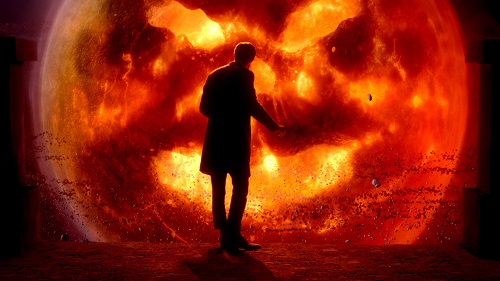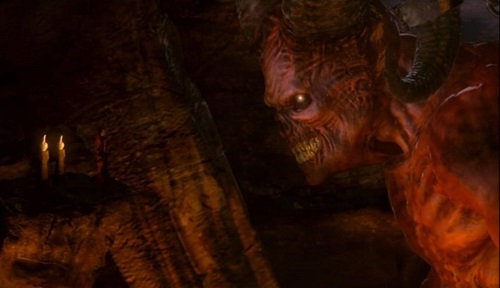
The Doctor confronts the old god in “The Rings of Akhaten.”
In case you haven’t heard, this year marks the fiftieth anniversary of Doctor Who. As a fan, I’ve wanted to pay homage to the show for some time, planning to write a post discussing the good Doctor and religion. Now seems as good a time as any, given that the most recent episode “The Rings of Akhaten” is a story in which the Doctor comes face to face with a “god.”
It’s a common enough theme in science fiction: the self-proclaimed deity who is unmasked as a pretender (think Star Trek: The Undiscovered Country—“What does God need with a starship?”). Still, the Doctor’s confrontations with religious beings are a little different than those in other science fiction series. He is, after all, a semi-divine figure himself. All space and time is at his disposal. He can go anywhere and anywhen. He’s more Q than Picard, if you will.
The Doctor’s confrontations with religious beings is different than in other science fiction. He is, after all, a semi-divine figure himself.
So when the Doctor comes up against a “god,” we know he’ll be able to expose it as a fraud. And it always is another a fraud. It might be a powerful being; it might be ancient. It might, as in the most recent episode, have existed for millennia, feeding on the offerings and worship of its followers. But whatever else it is, it is not truly divine. It is as much a part of the universe as anything else. It can always be explained. It can always be understood.
Except, perhaps, in one two-part story from the Tenth Doctor’s era. In this story, the Doctor again comes across someone professing godhood: he meets a being which claims to be the Beast, the devil himself. But the Doctor has faced many false gods in his day; they are all pretenders. “If you are the Beast,” he mocks, “then answer me this: Which one, hmm? Because the universe has been busy since you’ve been gone. There’s more religions than there are planets in the sky. There’s the Arkaphets, Christianity, Pash-Pash, New Judaism, San Claar, Church of the Tin Vagabond. Which devil are you?”
Only this time the devil is real. “Which devil are you?” the Doctor asks. “All of them,” the Beast replies. He is not lying.
Here the Doctor is confronted with something greater—and more terrifying—than he can imagine. Not merely because it is an unknown but instead because it is by its nature unknowable. When the Doctor asks the Beast when he came to be chained in the Pit, the latter answers, “Before time.” This answer makes no sense to the Doctor; he cannot conceive of a “before time.”
“What does ‘before time’ mean?” he asks.
“Before time and light and space and matter. Before the cataclysm. Before this universe was created.”
“You can’t have come from before the universe,” the Doctor responds incredulously. “That’s impossible.”
To which the Beast replies, “Is that your religion?”
The Doctor can only respond, “It’s a belief.”
The Beast scoffs, “You know nothing. All of you, so small.”
Here the Doctor, nigh on a deity himself, is confronted by something beyond him. Unknowable. Unthinkable. Impossible. He cannot conceive of existence before time and matter. His reason is too small; it cannot bend so far. He cannot comprehend it. He cannot measure it and test it. “If that thing had said it was from beyond the universe, I’d have believed it. But before? Impossible.”
So too did God question Job: “Where were you when I laid the earth’s foundation? Tell me, if you understand. Who marked off its dimensions? Surely you know! Who stretched a measuring line across it? On what were its footings set, or who laid its cornerstone?” (Job 38:4-6). The questions are, for Job, impossible to answer; they are beyond his understanding: “Surely I spoke of things I did not understand, things too wonderful for me to know” (Job 42:3). But Job’s inability to answer God’s questions about creation—and the Doctor’s inability to comprehend existence “before time”—does not change the fact of their existence.
So then: the Doctor finds himself opposed by a power he cannot even comprehend. He has no more ideas. He has no more options. Even the TARDIS—and, consequently, the only chance of escape—has been lost. All hope is at an end. The situation is utterly and completely beyond him.
The situation is utterly and completely beyond him. How fitting then, that the solution must also come from beyond him.
How fitting then, that the solution must also come from beyond him. It has, in fact, been prepared in advance by those who first imprisoned the devil. The Beast had been imprisoned “before time,” he tells us, when “the Disciples of the Light rose up against me and chained me in the pit for all eternity.”

The Doctor meets the Devil in “The Satan Pit.”
It is impossible to miss the reference to Scripture here. “And there was war in heaven. Michael and his angels fought against the dragon, and the dragon and his angels fought back. But he was not strong enough, and they lost their place in heaven. The great dragon was hurled down—that ancient serpent called the devil, or Satan, who leads the whole world astray” (Revelation 12:7-9). And again: “The angels who did not keep their positions of authority but abandoned their own home—these he has kept in darkness, bound with everlasting chains for judgment on the great Day” (Jude 6).
As in the biblical text, the devil was defeated and chained in the darkness (in the television series, the devil is quite literally chained on an “impossible planet” fixed in space in the shadow of a black hole). But the Disciples of the Light seem to have foreseen both the Beast’s attempt to escape and the Doctor’s presence at the event. When all hope is lost, the Doctor finds the Disciples of Light have prepared a solution for him ahead of time—quite literally before time existed.
Having fallen into the Pit, the Doctor awakens to find he was “expected.” “I was given a safe landing and air,” he says to the Beast, asking why. Slowly it dawns on him: provision for his safe descent was not the devil’s doing; it was the work of the Disciples of Light. “That’s it!” he exclaims. “You didn’t give me air, your jailers did! They set this up. They need me alive, because if you’re escaping then I need to stop you!” The Doctor discovers what the Disciples of Light intend him to do, and he does it—knowing full well it will mean his own death.
Except it doesn’t. In a deus ex machina worthy of the name, the Doctor’s previously lost TARDIS is discovered to have also fallen into the Pit. In fact, it’s landed right where it needs to be, almost as if by plan. And perhaps it was by plan. That’s what’s so fascinating about this particular Doctor Who story: it leaves room for the possibility of something more—something beyond mortal comprehension, beyond even the super-human Doctor’s understanding. The Doctor lays down his life to defeat the devil, only to find his life restored to him in the end.
God out of the machine indeed.
———————
The two-part story under discussion here is “The Impossible Planet” and “The Satan Pit.”
Cross-posted at A Christian Thing.
Tags: christian, Christianity, devil, Doctor Who, Dr. Who, faith, impossible planet, mythology, religion, Rings of Akhaten, Satan pit, science fiction

 That’s a selection from my column for the March/April issue of The Canadian Lutheran. Read the full article here: “A sea of life, a river of death.” The same issue has my long-feature story on visiting the Holy Land, so watch here for a link to it in the near future.
That’s a selection from my column for the March/April issue of The Canadian Lutheran. Read the full article here: “A sea of life, a river of death.” The same issue has my long-feature story on visiting the Holy Land, so watch here for a link to it in the near future.



